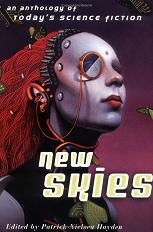
New Skies
Patrick Nielsen Hayden
275 pages
published in 2003
I didn't know this was meant to be an "anthology of today's science fiction" for a "new, younger generation of science fiction fans" until I got this home from the library, as I only got it because Patrick Nielsen Hayden was the editor and I was curious to see what his tastes were like. I thought New Skies was an anthology of new science fiction, but instead it's a showcase of science fiction stories from the last twenty years, aimed at an audience new to the genre. Still, it's as good a test of Patrick's tastes as any, as not only did he have to select his entries from over two decades of stories, but he also had to select them to show off the width and breadth of the genre, be not too long and accessible to younger reader. A huge task indeed.
Since I've been reading science fiction for quite some time now, I'm not exactly the target audience for New Skies; I don't know how some thirteen year old kid would like this book, but I enjoyed it. New Skies does a good job of representing how much different kinds of science fiction stories there are and how much fun they can be. None of the stories were the kind that makes your hair stand on edge, but they're good representations of what you can expect in science fiction and they're accesible.
- They’re Made Out of Meat Terry Bisson (1991)
Maybe the aliens wouldn't actually want to know us, once they get to know us... - A Walk in the Sun Geoffrey A. Landis (1991)
I'd read this before in some Year's Best anthology or other and liked it as much now as I did then. It's an almost perfect example of a style of science fiction story writers like Arthur C. Clarke specialised in, the heroic exploration of space story, of man (or woman) against nature. Here it's an astronaut stranded on the moon with a malfunctioning space suit which should keep her alive for the thirty days it will take rescue to get to her, as long as she can remain in sunlight to recharge the suit's batteries... - Peaches for Mad Molly Steven Gould (1988)
A great adventure story, set in a nasty future, showing that print science fiction can have just as much action as a science fiction movie. - Serpents’ Teeth Spider Robinson (1981)
The first story I didn't like, largely because Spider Robinson's writing style just gets on my nerves. It's a good example of a social science fiction story showcasing a future society very different from ours, but Robinson just doesn't sell it to me. - Uncle Joshua and the Grooglemen Debra Doyle & James D. Macdonald (1993)
A post-apocalypse scare story/fairy tale. - A Letter from the Clearys Connie Willis (1982)
When Connie Willis built her reputation in the early eighties, it was with stories such as this that are quite nasty or depressing to read. In this case it shows how things can get worse even once you survived World War III. - Brian and the Aliens Will Shetterly (1994)
Humourous story of how Brian foiled an alien invasion that didn't so much wanted to conquer Earth as redevelop it for their own purposes, which sadly meant all current life on it would die. - Different Kinds of Darkness David Langford (2000)
In my opinion the best story in the book. Jonathan and his friends had discovered there were two kinds of darkness: the regular kind, and the one the adults could look through but they couldn't. What was the reason for this and what was the connection with the bogey picture they used for their club rites that makes them feel funny in the head? - Will You Be an Astronaut? Greg van Eekhout (2002)
A story that's written as if it's a children's popup book, incluing the reader that way into why being an astronaut is such an important career choice in the future. - Cards of Grief Jane Yolen (1983)
Showcasing another thing that science fiction does well: showing off an alien society through focusing on one aspect of it. - Tangents Greg Bear (1986)
The story about the four-dimensional boy mentioned in the introduction. A mathematical puzzle story of the didactic kind. - The Alien Mind Philip K. Dick (1981)
A nice little nasty story from Dick, but the victim of the alien prank thoroughly deserves it. - Out of All Them Bright Stars Nancy Kress (1985)
Another kind of alien contact story, putting the alien into the everyday existence of a waiter in a smalltime diner. - The Lincoln Train Maureen F. McHugh (1995)
A good example of an alternate history story, as it's set in the aftermath of an American Civil War that ended slightly different from our own and the reader has to work to puzzle out exactly what's going on. - Arthur Sternbach Brings the Curveball to Mars Kim Stanley Robinson (1999)
The quentessential American pastime brought to Mars. There's always been a strong pastoral fantasy streak in American science fiction, no matter how paradoxical this sounds, going back all the way to Ray Bradbury's Mars stories and earlier authors like Henry Kuttner and Margaret St. Clair. This is a modern version of this sort of story. - Salvage Orson Scott Card (1986)
The other discordant note in this anthology is another of Orson Scott Card's post-apocalyptic Mormon fantasies. A nice enough story, but it does read somewhat as Mormon propaganda and considering Card's politics I'm uncomfortable with even reading a short story by him. - The Great Goodbye Robert Charles Wilson (2000)
A modern version of a classic sort of trick or twist science fiction story.
Read more about:
Patrick Nielsen Hayden,
New Skies,
science fiction,
book review